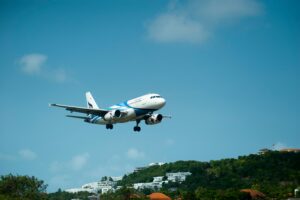A Friendly Guide to your confidence on the Plane
Flying can be a daunting experience for many people. The mere thought of being thousands of feet above the ground in a metal tube can trigger anxiety and fear. If you find yourself dreading your next flight, don’t worry—you’re not alone. Many people share this fear, and there are effective strategies to help you manage it. In this guide, we’ll explore practical tips and techniques to help you overcome your fear of flying and make your air travel experience more enjoyable.
Understanding Your Fear of Flying
Before diving into the strategies, it’s essential to understand what fuels your fear of flying. This fear can stem from various factors, such as:
- Fear of Heights: Being high above the ground can be unsettling.
- Lack of Control: Not being in control of the aircraft can be anxiety-inducing.
- Turbulence: The sensation of turbulence can make you feel unsafe.
- Claustrophobia: The confined space of an airplane can trigger discomfort.
- Past Experiences: A previous bad experience on a flight can lead to ongoing fear.
Recognizing the root cause of your fear is the first step toward overcoming it.
1. Educate Yourself About Flying
Knowledge is power, and understanding how airplanes work can significantly reduce your anxiety. Modern aircraft are designed with advanced technology and safety features, and pilots undergo rigorous training to ensure passenger safety.
What to Learn:
- Aircraft Mechanics: Learn how airplanes are built and maintained.
- Pilot Training: Understand the extensive training pilots receive.
- Turbulence Facts: Discover why turbulence is usually harmless.
Tips:
- Watch documentaries about aviation.
- Read articles and books about how planes fly.
- Attend a fear of flying course, if available.
2. Practice Relaxation Techniques
Relaxation techniques can help calm your mind and body before and during your flight.
Techniques to Try:
- Deep Breathing: Practice deep breathing exercises to help you stay calm.
- Meditation: Use meditation apps or guided meditation sessions to reduce anxiety.
- Progressive Muscle Relaxation: Tense and then relax different muscle groups to ease tension.
Tips:
- Download relaxation apps before your flight.
- Practice these techniques regularly, even when you’re not flying.
3. Use Visualization
Visualization is a powerful tool to help you overcome your fear of flying. By imagining yourself having a smooth and enjoyable flight, you can train your mind to associate flying with positive experiences.
How to Visualize:
- Close your eyes and take a few deep breaths.
- Imagine yourself boarding the plane, finding your seat, and feeling relaxed.
- Visualize the plane taking off smoothly, cruising at altitude, and landing safely.
Tips:
- Practice visualization daily in the weeks leading up to your flight.
- Use positive affirmations to reinforce your visualization.
4. Distraction is Key
Keeping your mind occupied can prevent you from dwelling on your fear. Bring activities that you enjoy to help pass the time during your flight.
Distraction Ideas:
- Books and Magazines: Bring a captivating book or your favorite magazines.
- Movies and TV Shows: Download movies or TV shows to watch on your device.
- Music and Podcasts: Create a calming playlist or download interesting podcasts.
Tips:
- Invest in noise-canceling headphones to block out airplane noises.
- Choose content that genuinely interests you to keep your mind engaged.
5. Talk to a Professional
If your fear of flying is severe, consider seeking help from a mental health professional. Therapists can use various techniques, such as cognitive-behavioral therapy (CBT), to help you manage your anxiety.
Professional Help Options:
- Therapy: Find a therapist who specializes in anxiety or phobias.
- Support Groups: Join a fear of flying support group to share experiences and tips.
- Online Resources: Utilize online therapy options if in-person sessions are not feasible.
Tips:
- Don’t hesitate to reach out for help—many people benefit from professional support.
- Consider starting therapy well before your planned flight to allow time for progress.
6. Choose the Right Flight and Seat
Certain flight choices can help reduce your anxiety and make your journey more comfortable.
What to Consider:
- Direct Flights: Choose direct flights to minimize takeoffs and landings.
- Time of Day: Fly during the day when turbulence is typically less severe.
- Seat Selection: Opt for a seat over the wing where the ride is smoother.
Tips:
- Book your flights early to get your preferred seats.
- Check the airline’s policies for any accommodations they may offer for anxious flyers.
7. Communicate with the Crew
Airline staff are trained to assist passengers with various needs, including those who are anxious about flying.
How to Communicate:
- Before the Flight: Inform the airline staff about your fear when you check-in.
- During the Flight: Let the flight attendants know if you’re feeling anxious—they can provide reassurance and support.
Tips:
- Don’t be afraid to ask questions about the flight or the aircraft.
- Trust that the crew’s primary goal is your safety and comfort.
Conclusion
Overcoming your fear of flying takes time and effort, but with the right strategies and support, it is possible to enjoy a more relaxed and confident flying experience. By educating yourself, practicing relaxation techniques, seeking professional help if needed, and making mindful flight choices, you can turn your fear into a manageable challenge. Remember, millions of people fly every day, and with each flight you take, you’ll build more confidence and reduce your anxiety. Safe travels!
